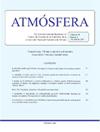巴西冬季日大气环流型的分类
IF 1
4区 地球科学
Q4 METEOROLOGY & ATMOSPHERIC SCIENCES
引用次数: 0
摘要
本研究提出了巴西冬季(6、7、8月)地面和500 hPa的天气分类,以确定影响这一时期天气的主要天气尺度气象系统。通过主成分分析(PCA),确定了1979—2020年冬季的5种主要天气模式,且3个分析月份的天气模式基本相同。最常见的天气型与气候平均场(CMF)有关,以南美洲两个最具特征的低层大气环流系统为代表:南大西洋副热带高压(SASH)和西北阿根廷低压(NAL)。在巴西南部(CF_SUL)和东南部(CF_SE)地区,还有另外两个与经典冷锋有关的天气型。最后,另外两种天气型分别与大西洋上空的阻塞反气旋(BAn)和气旋形成(CG)过程有关。它们都与巴西上空最常见的冷潮和“Friagens”天气型相对应。本文章由计算机程序翻译,如有差异,请以英文原文为准。
Classification of wintertime daily atmospheric circulation patterns over Brazil
This study presents a synoptic classification at surface and at 500 hPa during the winter (June, July, and August) over Brazil, in order to identify the main synoptic-scale meteorological systems that influence the weather of this period. Through the Principal Components Analysis (PCA) for the 1979-2020 period, it was identified five main synoptic patterns that predominated during the winter which are practically the same for each of the three analyzed months. The most frequent synoptic pattern is associated with the climatological mean-field (CMF), represented by the two of the most characteristic systems of low-level atmospheric circulation in South America: The South Atlantic Subtropical High (SASH) and the North-Western Argentinean Low (NAL). There are two other synoptic patterns related to a classical cold front over the Southern (CF_SUL) and Southeastern (CF_SE) regions of Brazil, respectively. Finally, two other synoptic patterns are associated with a blocking anticyclone (BAn) and a cyclogenetic (CG) process over the Atlantic Ocean, respectively. Both of them correspond to the most frequent synoptic pattern related to cold waves and "Friagens" over Brazil.
求助全文
通过发布文献求助,成功后即可免费获取论文全文。
去求助
来源期刊

Atmosfera
地学-气象与大气科学
CiteScore
2.20
自引率
0.00%
发文量
46
审稿时长
6 months
期刊介绍:
ATMÓSFERA seeks contributions on theoretical, basic, empirical and applied research in all the areas of atmospheric sciences, with emphasis on meteorology, climatology, aeronomy, physics, chemistry, and aerobiology. Interdisciplinary contributions are also accepted; especially those related with oceanography, hydrology, climate variability and change, ecology, forestry, glaciology, agriculture, environmental pollution, and other topics related to economy and society as they are affected by atmospheric hazards.
 求助内容:
求助内容: 应助结果提醒方式:
应助结果提醒方式:


